#Five Dynasties & Ten Kingdoms Period(907-979)
Text
[Hanfu · 漢服]Chinese Five Dynasties & Ten Kingdoms Period(907-979) Traditional Clothing Hanfu





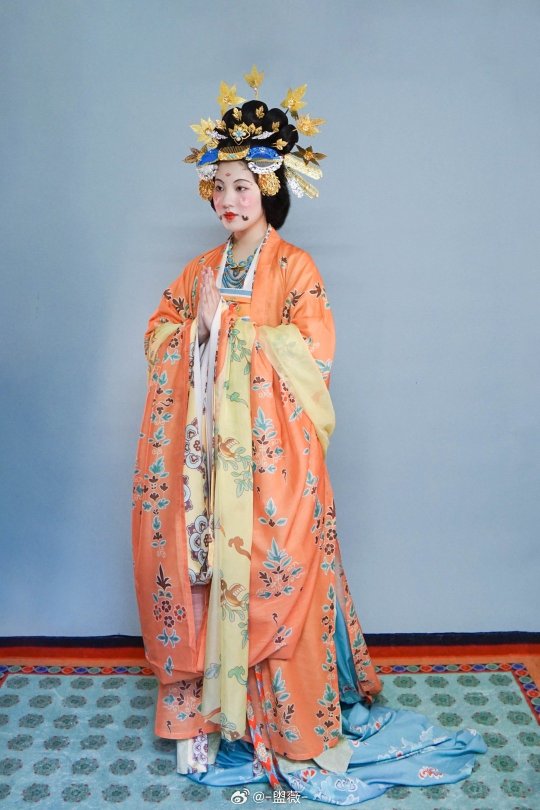

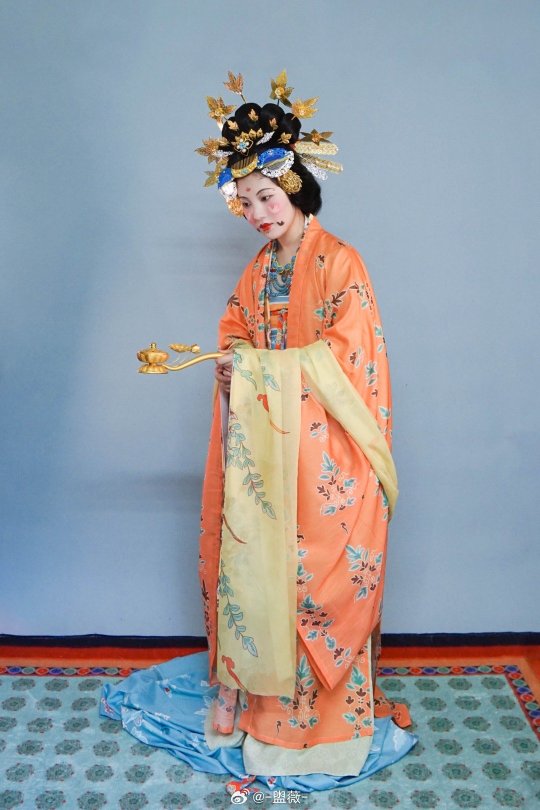



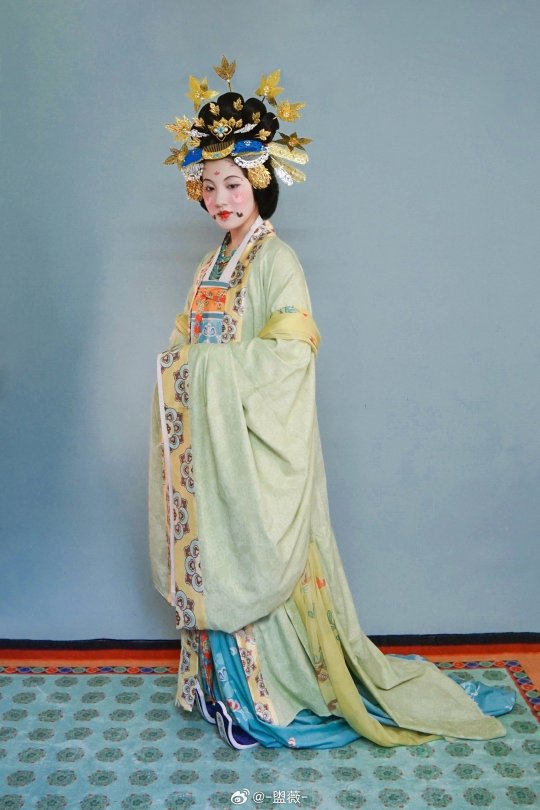


【Historical Reference Artifacts】:
The donor of Cave 98 of Mogao Grottoes in China, Five Dynasties & Ten Kingdoms Period Cao Yijin(曹议金) family "supported by the bride Zhai/新妇娘子翟氏供养"
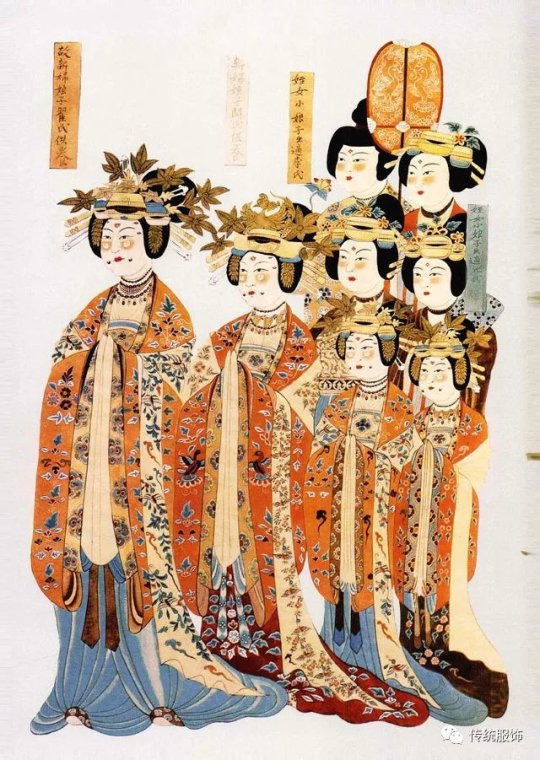

————————
Recreation Work: @-盥薇-
👗Hanfu:@青泠谷汉服工作室
🔗Weibo:https://weibo.com/3942003133/NqzfOau9r
————————
#chinese hanfu#Five Dynasties & Ten Kingdoms Period(907-979)#hanfu#hanfu accessories#hanfu_challenge#chinese traditional clothing#china#chinese#hanfu history#hanfu art#chinese history#chinese historical hairstyle#chinese historical makeup#china history#漢服#汉服#中華風#chinese style#-盥薇-#青泠谷汉服工作室 #hanfu recreation
312 notes
·
View notes
Text
Chuang argues that untill the nineteenth century there was essentially no such thing as China, the word didn't exist and neither did the concept. For example:
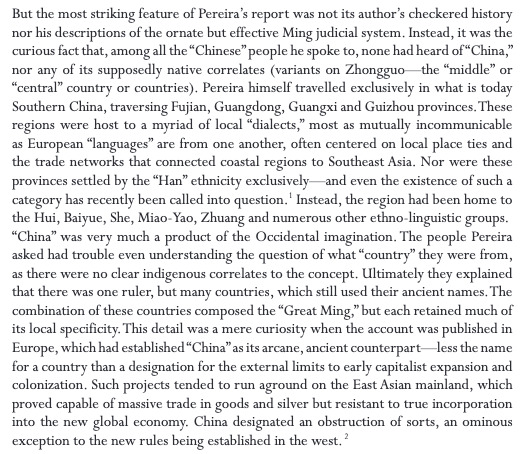
It seemed really hard to believe to me, that there was no concept for this huge state which had existed for nearly two thousand year in roughly the same location, and which, though it often changed dynasties or split apart, always ended up reforming.
But looking at the timeline of imperial China, the periods of division are much longer than I thought, the "ephemeral" divided states often lasted generations or centuries, and some Chinese dynasties only ruled the entirety of "China proper" for a very brief period of time.
The period considered "golden ages" are almost the same as the period of lasting rule of the whole of "China proper" by a native Chinese dynasty. That means the latter is quite rare.
Starting in 221 BCE we have the founding of the Qin Empire, which lasts only fourteen years, after five years of division comes the Han Empire, which except for a brief interuption by the Xin Dynasty rules continuously untill 22O CE.
Then we have the Three Kingdoms period which ends with the Jin unification in 280 CE. But though the Jin Dynasty would last longer, they only ruled the whole of China for a pathetic 24 years. Then there's the Sixteen Kingdoms period, followed by the Northern and Southern Dynasties period.
In 581 CE there's the founding of the Sui dynasty, which is replaced by the Tang Dynasty after only 37 years. The Tang would last 289 years.
In 907 CE the Five dynasties and Ten Kingdoms period begins. In 979 the Song dynasty is founded. I wasn't sure if the Northern Song should be counted as a united China. They ruled most of it, but there were still two other dynasties, the Western Xia and Liao. Ultimately I decided it didn't count because Xia and Liao, althought founded by non-chinese, seem to have been "Chinese-style" empires and controlled some territories in China proper (including Beijing!). By the Southern Song, The Liao had been replaced by the Jin (unrelated to the previous Jin dynasty) and the Song had lost contol of even more "core Chinese" territory. Then the Mongols show up, and do their usual thing.
This leads to the creation of the Yuan dynasty in 1279, which only rules for 89 years before beeing replaced by the Ming in 1368, which are then conquered by the Qing Dynasty in 1644, which rules China until 1912.
I think you can roughly periodize the imperial era as such:
There's the "Old Empire" from 221BCE to 220 CE, which is mostly just the Han dynasty. That's 441 years.
A "First Intermediate Period" of almost continuous division (the cringe Jin basically don't count) from 220 CE to the Sui unification of 581. That's an enormous 361 years.
A "Middle Empire"frome 581 to 907 (326 years total), which is mostly just the Tang dynasty.
A "Second Intermediate Period" from 907 to 1279 (372 years!) where again there is aways several states in China proper.
The "New Empire" from 1279 to 1912 (633 years), which lasts much longer than the other twos, but more than half of the time it is under a foreign dynasty.
(I am well aware of how presumptuous it is to make up my own periodization of Chinese history based off glancing at Wikipedia)
Overall, from 221 BCE to 1912 CE, (2133 years):
China is united under a "native" dynasty for only 1062 years (50% of the time).
It is united under a "foreign" dynasty for 357 years (17% of the time)
It is several states for 714 years (33% of the time).
There were only three "native" dynasties which ruled the whole of China for a non-trivial amount of time (Han, Tang and Ming), and one "foreign" dynasty (the Qing).
So I guess it's plausible than people would not have conceived of "mainland East Asia (as Chuang calls it) as one country which is periodically divided, but instead several countries which are occasionnally united.
7 notes
·
View notes
Photo

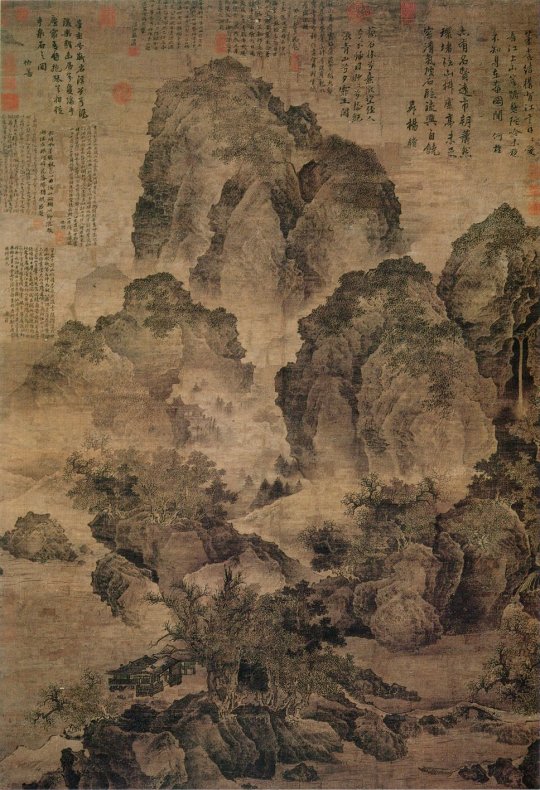
Jing Hao (c. 855—915), Mount Lu, Five Dynasties and Ten Kingdoms period (907-979 C.E.), hanging scroll, ink on silk, National Palace Museum, Taipei.
Fan Kuan (10th—early 11th century), Sitting Alone by a Stream, Song dynasty (960-1279 C.E.), National Palace Museum, Taipei.
49 notes
·
View notes
Text
Beautiful rural public cultural space recommended in city
Five places in Suzhou are added as the “most beautiful national-level rural public cultural space” recently. Let’s check them out.
Yuandang Xiaoguan元荡小馆
The south side of Yuandang Xiaoguan is utilized for comprehensive exhibition, demonstrating the development of Yuandang in various periods of Chinese history from ancient times to the Five Dynasties (907-960) and Ten Kingdoms (902–979), and…
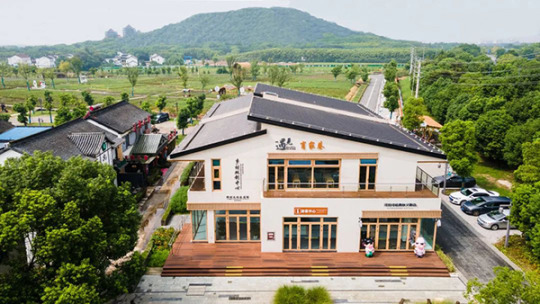
View On WordPress
0 notes
Photo


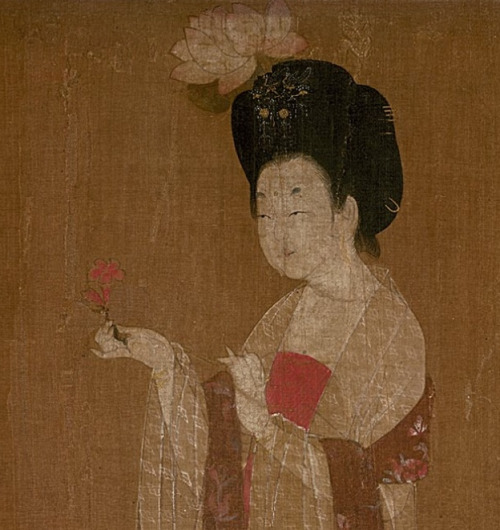
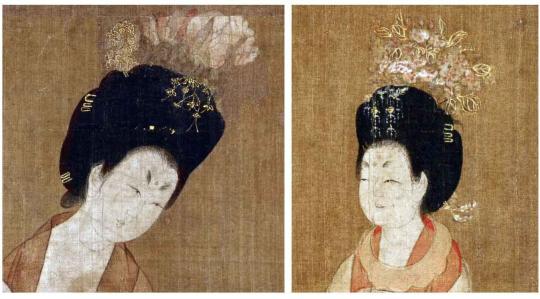
This painting, “Ladies with Flower Pins” 簪花仕女图, traditionally attributed to the famous Tang Dynasty artist Zhou Fang 周昉 (about 730-800) is often used as an example of the High Tang fashion. Many portrayals of Yang Guifei in art and on tv are based on it.
However, recent researches consider it unlikely that “Ladies with Flower Pins” was created in the Tang era:
The earliest mentions of this painting appear during the Song Dynasty. Back then it was believed that “Ladies with Flower Pins” was created after the fall of Tang. Only several hundred years later, during the Qing Dynasty, this painting was attributed to Zhou Fang and thus dated to the Tang Dynasty.
However, in recent years similar hair ornaments were unearthed in tombs of ladies of Five Dynasties and Ten Kingdoms period (907-979) - a turbulent era between Tang and Song. Similar clothes and hairstyles appear on tomb figurines, and on murals in Dunhuang, dated to the same period:

There are no murals, figurines, or paintings created during the Tang Dynasty that portray similar fashions.
Also, during the restoration of “Ladies with Flower Pins”, it was discovered that initially this painting served as a folding screen which was later partially repainted and transformed into a single piece. This is another argument against Zhou Fang’s authorship since he didn’t paint folding screens.
The book 中国妆束: 大唐女儿行 (about Tang Dynasty female fashion) presumes that “Ladies with Flower Pins” was created in the Southern Tang state. (The Southern Tang state shouldn’t be confused with THE Tang: the Tang Empire ended in 907, and the Southern Tang state existed in 937-976 during Five Dynasties and Ten Kingdoms period.)
For comparison, here are paintings that were undoubtedly created by Zhou Fang and show fashions of the so called High Tang period:
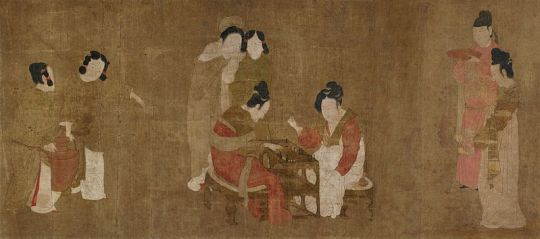
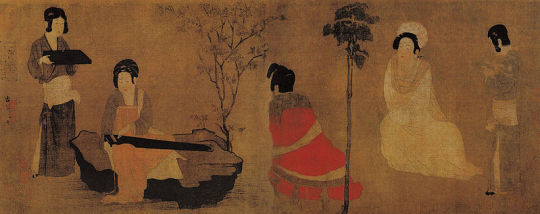
Sources:
中国妆束: 大唐女儿行
https://baike.baidu.com/item/%E7%B0%AA%E8%8A%B1%E4%BB%95%E5%A5%B3%E5%9B%BE
http://collection.sina.com.cn/jczs/2018-07-23/doc-ihftenhy7549507.shtml
https://www.zhihu.com/question/35252979
https://www.sohu.com/a/233793416_772609
159 notes
·
View notes
Photo
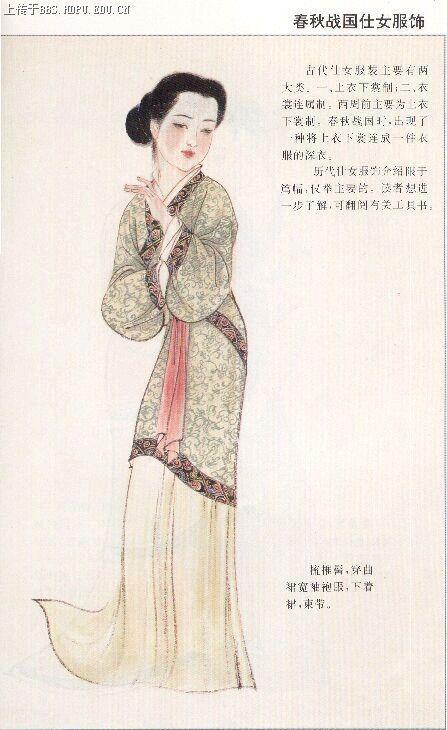



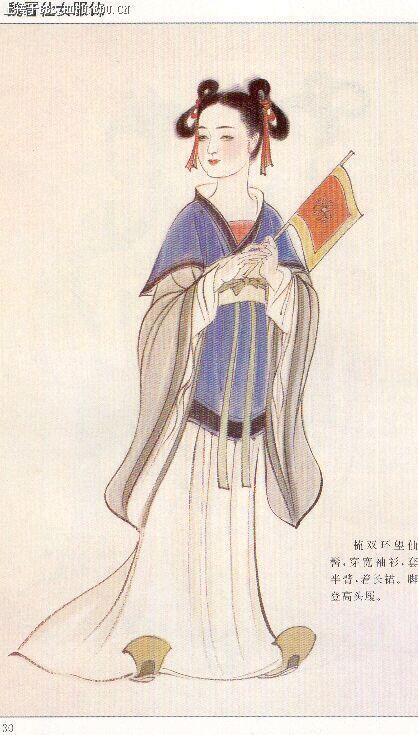



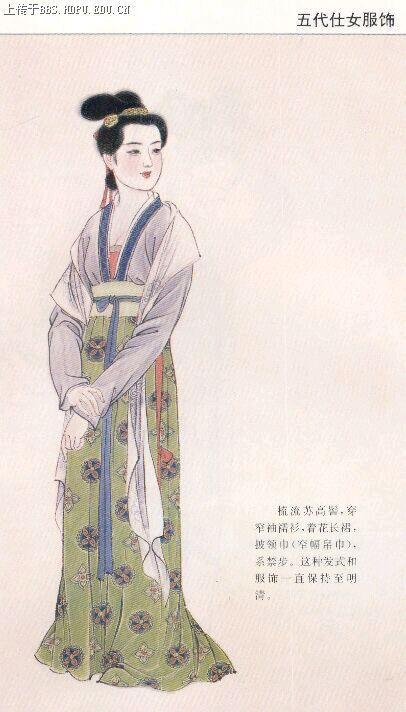

First Line: Spring and Autumn and Warring States Period(770 BC-221 BC)
Line 2: Han Dynasty (202 BC ~ 220 AD)
Third row: Wei and Jin dynasties (220 – 420)
Fourth row: Sui Dynasty (581 – 618)
Line 5: Tang Dynasty (618 – 907)
Row 6: Five Dynasties and Ten Kingdoms (907 – 979)
Line 7: Ming Dynasty (1368-1644)
#hanfu#china fashion#chinese fashion#fashion#historical costume#china#chinese costumes#chinese culture
248 notes
·
View notes
Text
[Hanfu · 漢服]Chinese Five Dynasties & Ten Kingdoms Period(907-979) Traditional Clothing Hanfu Based On Dunhuang Murals
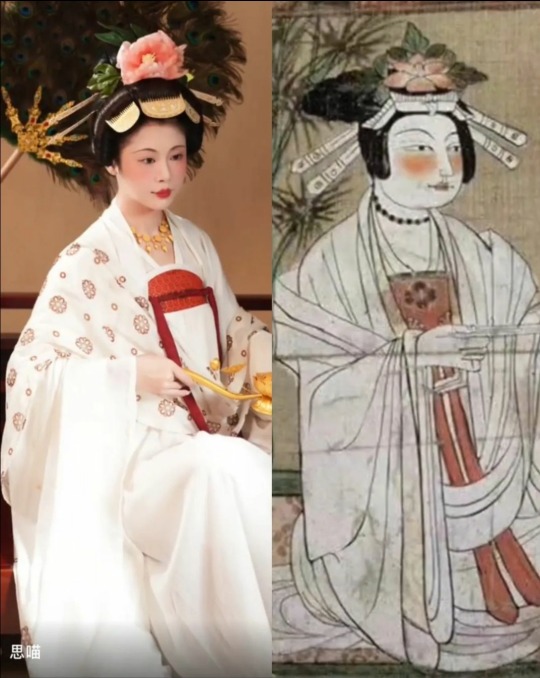
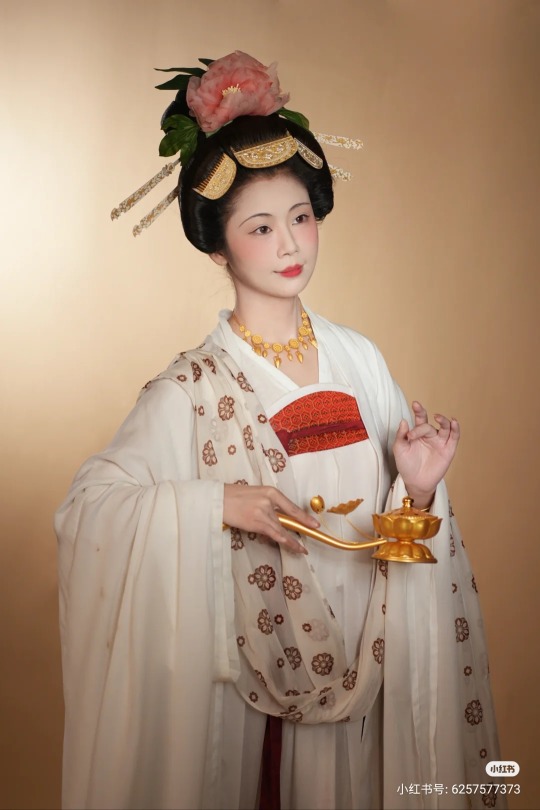
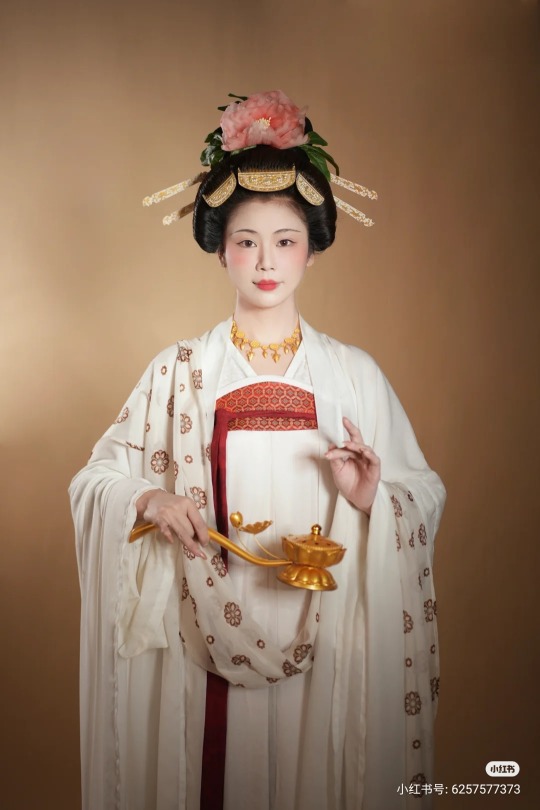

【Historical Artifacts Reference 】:
Restoration Based On Chinese Five Dynasties Period (981 AD) Dunhuang Murals:
<Buddhist donatress Chang, Mogao Grottoes,Buddhist donor, detail of 1000-armed, 1000-eyed Avalokiteshvara. Dunhuang, Mo-kao Cave No. 17, 981 AD, Guiyi era(Five Dynasties and Ten Kingdoms period). Painting on silk>

————————
📸Recreation Work: @思喵
🧚🏻♀️Model:@思喵
💎Hairpin:@华髻国风艺术首饰
🔗Xiaohongshu App:http://xhslink.com/IqOc2A
————————
#chinese hanfu#Five Dynasties & Ten Kingdoms Period(907-979)#hanfu#hanfu accessories#hanfu_challenge#chinese traditional clothing#china#chinese#hanfu history#chinese history#chinese historical fashion#漢服#汉服
113 notes
·
View notes
Text
[Hanfu · 漢服]Chinese Five Dynasties & Ten Kingdoms Period(907-979) Traditional Clothing Hanfu Photoshoot
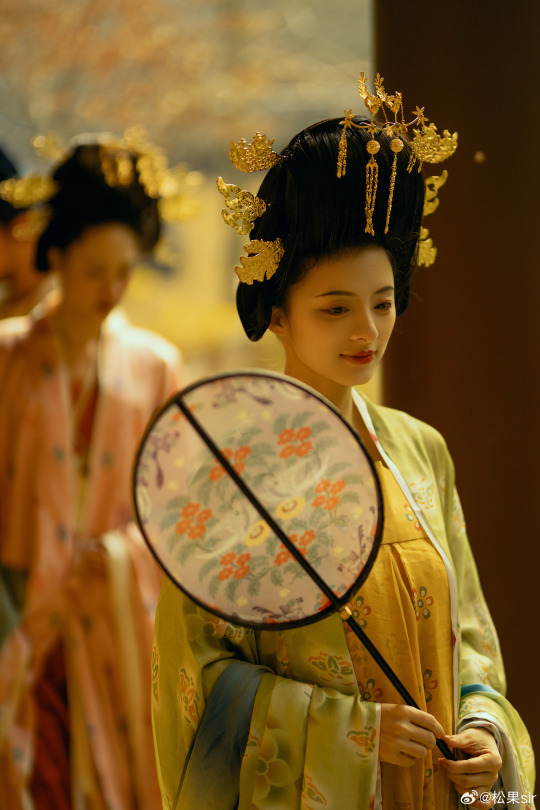
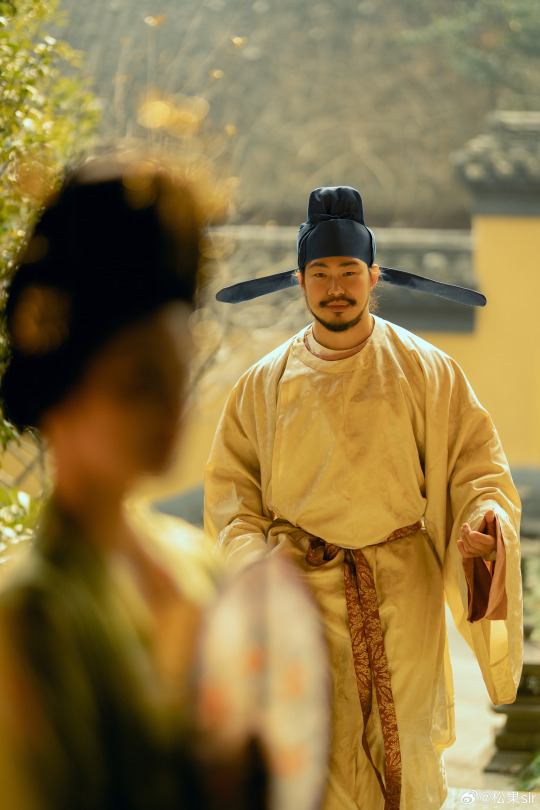
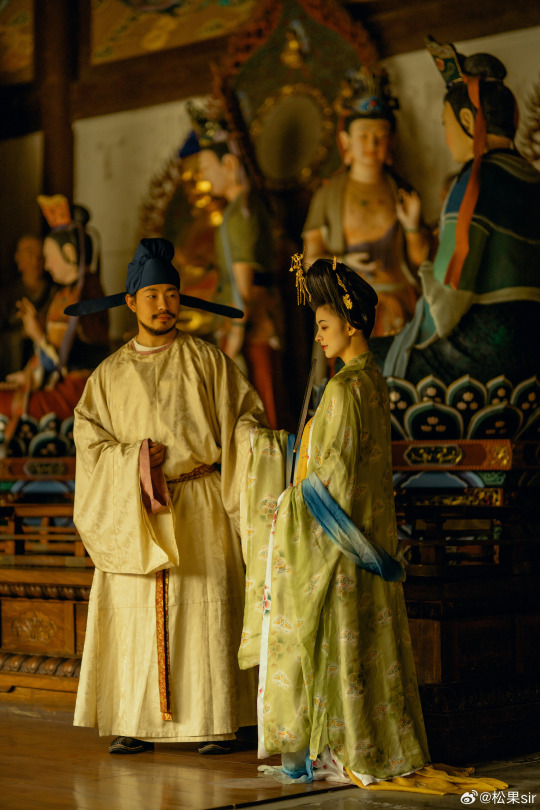
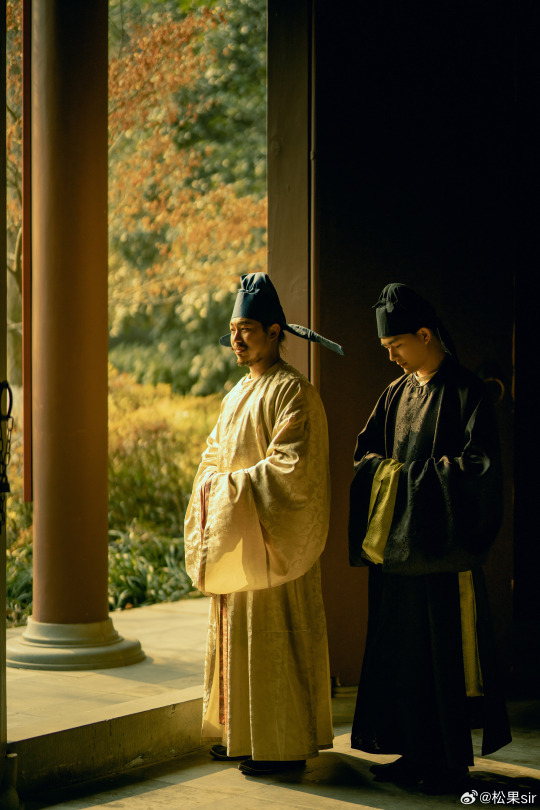



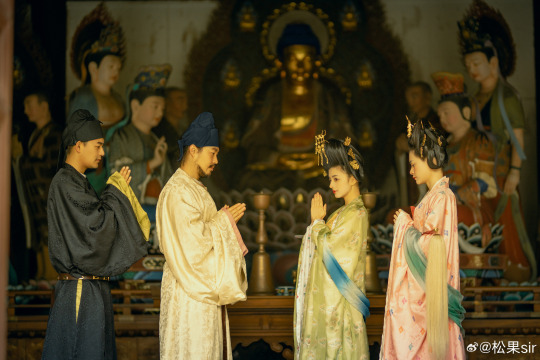




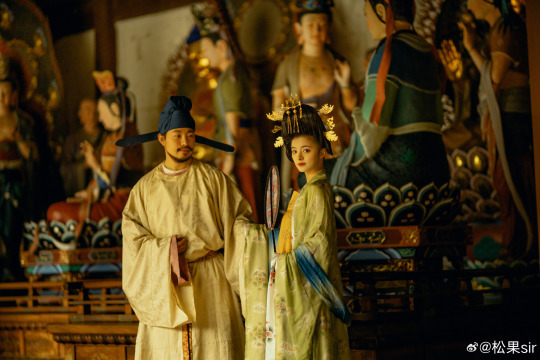





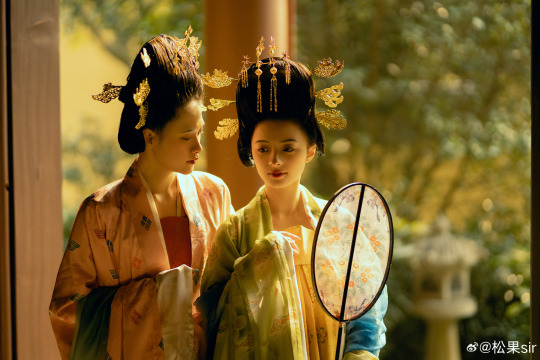


_______
🧚🏻🙋♂️ Model:@终南山下活死人墓祖师婆婆林朝英 @阿时Ashi_ @阿杬在吗“先生王騰”
Support staff:@鱼汤小哥哥 “王正义”
👗Hanfu: @鱼汤传统服饰 @桑纈 @宇宙尘兔
📸Photographer: 松果sir
Round Fan:@妃加
Fly-whisk:@槛外人武陆柒567
🔗Weibo:https://weibo.com/3250619702/NBvbcsivj
_______
#chinese hanfu#five dynasties and ten kingdoms period#hanfu#hanfu accessories#hanfu_challenge#chinese traditional clothing#china#chinese#hanfu photoshoot#hanfu girl#man hanfu#hanfu art#漢服#汉服#中華風#chinese style
225 notes
·
View notes
Text
[Hanfu · 漢服]Chinese【Late Tang Dynasty-Five Dynasties & Ten Kingdoms Period(907-979)】Traditional Clothing Hanfu Reference to Dunhuang Silk Painting


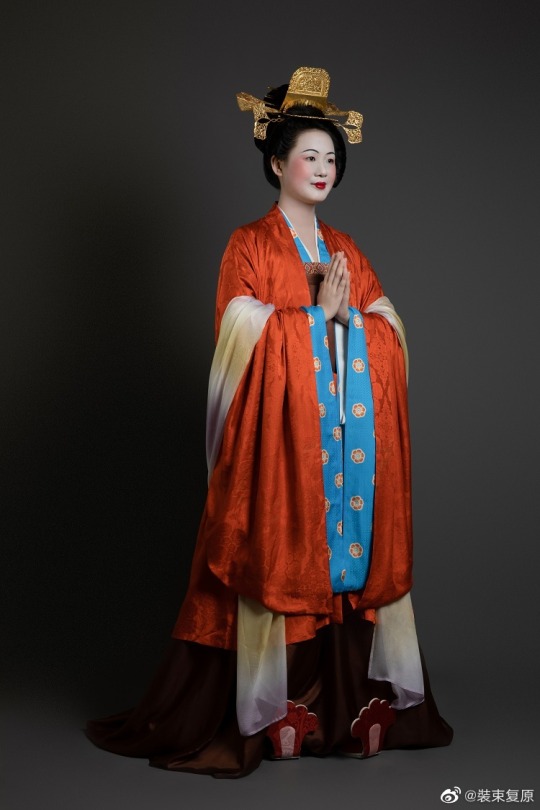
【Historical Reference Artifacts】:
1.China Five Dynasties Silk Painting:
Name: 《药师琉璃光如来》
Medium: Color on silk
Artist: Anonymous
Dimension: 72.5 x 55.5 cm
Location: The British Museum
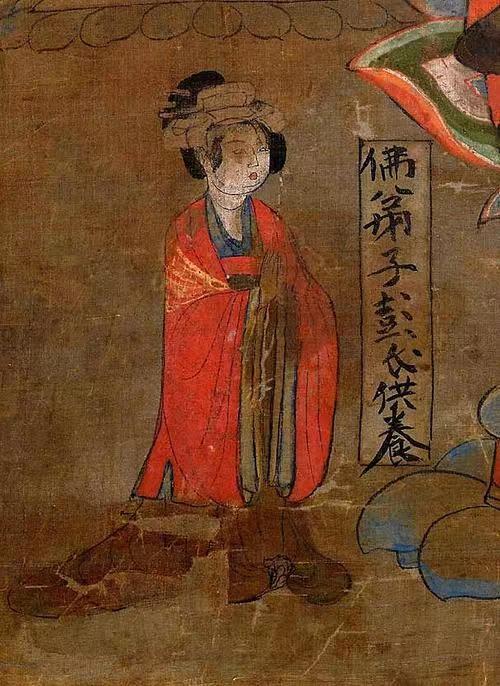
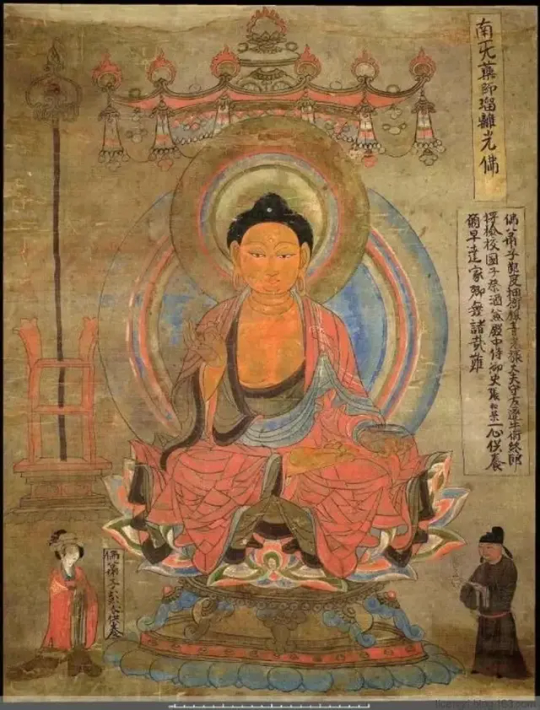
2.China Northern Song Dynasty Silk Painting:《释迦说法图》(around 951-1000)

【History Note】
During the late Tang Dynasty and the Five Dynasties, the attire of aristocratic women continued the extravagant and gorgeous style of the mid-Tang Dynasty. The size of shirts and skirts further increased, and high buns and large-sleeved shirts and skirts were popular, showing an aesthetic trend from wide and puffy to slender.
With such changes in fashion, slender, gorgeous and elegant blouses and long skirts have become the attire for women at that time to attend formal occasions. Paired with a grand and square bun with a single hairpin, slender and flexible flower hairpins on both sides, and a delicate and gorgeous gold comb in the front of the bun, the overall look is more solemn, elegant, gorgeous and brilliant.
The comb worn in this outfit was restored from the gold comb with Jile Feitian pattern unearthed in Sanyuan Road, Yangzhou. It is huge in size and exquisite in craftsmanship, which fully demonstrates the superb level of gold jewelry production at that time. It is still shining brightly after more than a thousand years.
The woman wears a blue printed shirt with a long skirt, and a large-sleeved shawl made of "Crimson Dabao Xianghua Ling/大宝相花绫" on the outside, with a silk wrapped around her shoulders. This is the typical attire of female donor of Dunhuang silk paintings at that time, and is full of the rhythm of the late Tang Dynasty and the Five Dynasties beauty standard.
________________________________
📸Recreation Work:@裝束复原
🔗Weibo :https://weibo.com/1656910125/N4Gil06QV
________________________________
#chinese hanfu#late tang dynasty#five dynasties and ten kingdoms#hanfu#hanfu accessories#hanfu_challenge#chinese traditional clothing#china#chinese#hanfu history#chinese fashion history#historical fashion#hanfu art#hanfu girl#漢服#汉服#中華風#chinese fashion#historical hairstyle#裝束复原
132 notes
·
View notes